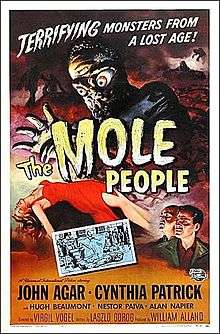The Mole People (film)
| The Mole People | |
|---|---|
 Poster by Joseph Smith | |
| Directed by | Virgil W. Vogel |
| Produced by | William Alland |
| Written by | László Görög |
| Starring |
John Agar Hugh Beaumont Cynthia Patrick |
| Distributed by | Universal-International |
Release dates |
|
Running time | 77 minutes |
| Country | United States |
| Language | English |
| Budget | $200,000 |
The Mole People is a 1956 science fiction film directed by Virgil W. Vogel. Universal released the film in December of 1956, simultaneously with their jungle adventure film Curucu, Beast of the Amazon. The two films appear to have been released on a double feature.
Plot
A narration by Dr. Frank Baxter, an English professor at the University of Southern California, explains the premise of the movie and its basis in reality. He briefly discusses the hollow earth theories of John Symmes and Cyrus Teed among others, and says that the movie is a fictionalized representation of these unorthodox theories.
Archaeologists Dr. Roger Bentley and Dr. Jud Bellamin find a race of Sumerian albinos living deep under the Earth. They keep mutant humanoid mole men as their slaves to harvest mushrooms, their primary food source, since mushrooms can grow without sunlight. The Sumerian albinos' ancestors relocated into the subterranean after cataclysmic floods in ancient Mesopotamia. Whenever their population increases, they sacrifice old people to the Eye of Ishtar, which is really natural light coming from the surface. These people have lived underground for so long that they are weakened by bright light which the archaeologists brought in the form of a flashlight. However, there is one girl named Adad who has natural Caucasian skin who is disdained by the others since she has the "mark of darkness." They believe the men are messengers of Ishtar, their goddess.
When one of the archaeologists is killed by a mole person, Elinu, the High Priest, realizes they are not gods. He orders their capture and takes the flashlight to control the Mole People, not knowing it is depleted. The archaeologists are then sent to the Eye just as the Mole People rebel. Adad goes to the Eye only to realize its true nature and that the men had survived. They then leave for the surface. Unfortunately, Adad dies after reaching the surface, when an earthquake causes a column to fall over and crush her.
Cast
- John Agar as Dr. Roger Bentley
- Cynthia Patrick as Adad
- Hugh Beaumont as Dr. Jud Bellamin
- Alan Napier as Elinu, the High Priest
- Nestor Paiva as Prof. Etienne Lafarge
- Phil Chambers as Dr. Paul Stuart
- Rodd Redwing as Nazar
- Robin Hughes as First Officer
- Frank Baxter as Himself
Uncredited
- Joe Abdullah as Arab Foreman
- Yvonne De Lavallade as a Dancer
- John Dodsworth as a Priest
- Arthur D. Gilmour as Sharu
- Marc Hamilton as a Priest
- Bob Herron as a Mole Person
- Robert F. Hoy as a Mole Person
- Kay E. Kuter as a Priest
- James Logan as an Officer
- Billy Miller as an Arab Boy
- Eddie Parker as a Mole Person
- Joe Rubino as a Mole Person
- Patrick Whyte as a Guard
Home media
Universal released The Mole People on DVD in a boxed set called The Classic Sci-Fi Ultimate Collection, which features 4 other classics as well (The Incredible Shrinking Man, Monster on the Campus, The Monolith Monsters and Tarantula).
In Mystery Science Theater 3000
This movie was featured on the television program Mystery Science Theater 3000. The characters respond to the abrupt and unsatisfying ending by bitterly declaring "So that's how you want to end your film? Okay, get bent."; the ending was changed from a typical happily-ever-after scenario because members of the studio felt that Bently's romance with Adad would promote interracial relationships.
A segment of this movie was used for the 1968 movie The Wild World of Batwoman, as creatures created by one of the movie's villains. This use was itself parodied by Mystery Science Theater 3000, with Crow T. Robot and Tom Servo mocking the classic slogan for Reese's Peanut Butter cups followed by Mike Nelson imitating the movie's villain, proclaiming "That's enough of THAT film."
Mythology
The fictionalized Mesopotamian history presented by the movie is based largely on Panbabylonism, as both Sumerian and Judaic stories describe the same events of the movie. Dr. Bentley states that the Biblical flood is an established archaeological fact, and the stranding of the Sumerians atop the mountain is a reference to the tale of Noah's Ark.

Similarly to the protagonists of the movie Ishtar descends to the underworld.[1] There is a Panbabylonic connection between Ishtar’s descent and the Old Testament story of Joseph. The descent to the underworld is a common story of world mythologies, as is the flood myth.
The movie erroneously associates Ishtar and the Sumerians. Ishtar was the Babylonian counterpart of the Sumerian goddess Inanna. The imagery associated with Ishtar in the movie is entirely fictional: Ishtar’s symbol was an eight-pointed star[2] representing Venus rather than the uneven chevron in the movie. Viewers might also notice that all of the gods depicted on the temple walls are Egyptian, not Sumerian.
Adad is an Akkadian (male) storm-god, counterpart to the Sumerian Ishkur.
See also
- Mole Man (1961), character from the Marvel Universe
References
External links
- The Mole People at the Internet Movie Database
- The Mole People at AllMovie
- MST3K Episode Guide: The Mole People
- DVD Review of The Mole People